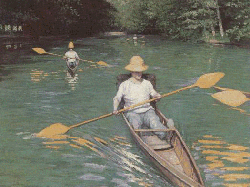

 The more distant an object, say a person, is the
smaller the image of that object will be on your retina, the back of the eye where we
really begin to "see". This effect on object size as distance increases is
illustrated in the figure to the right. The arrows are the same size (I cut and pasted the
two red arrows just to make sure). The black lines to each arrow indicate the size of the
object at the eye. Notice how much larger the angle formed by the black lines to the
closer arrow is (there are gray regions on each side of the angle formed by the black
lines to the more distant arrow). This reducing in size at the eye is part of the reason
that people look like ants as you fly in an airplane and stars appear as dots even though
they are enormous. An object's smaller size on your retina when it is farther away from
you is called relative size.
The more distant an object, say a person, is the
smaller the image of that object will be on your retina, the back of the eye where we
really begin to "see". This effect on object size as distance increases is
illustrated in the figure to the right. The arrows are the same size (I cut and pasted the
two red arrows just to make sure). The black lines to each arrow indicate the size of the
object at the eye. Notice how much larger the angle formed by the black lines to the
closer arrow is (there are gray regions on each side of the angle formed by the black
lines to the more distant arrow). This reducing in size at the eye is part of the reason
that people look like ants as you fly in an airplane and stars appear as dots even though
they are enormous. An object's smaller size on your retina when it is farther away from
you is called relative size.
The animation below will let you see how relative size can work as a depth cue. Clicking the Grow Fast button (or pressing the number 1 key) will have the blue circle go from small to large. For most people, it will also look like it gets closer. The Shrink Fast (2) button will have the blue circle go from large to small and for most people it will look like it moves away in depth. The plus and minus will make the blue circle get larger and smaller a little step at a time. If the plus and minus are not visible on the interactivity, you can click on the Step Circle (s) button to bring it back. [This animation uses Flash. You can get a free player here.]
Paintings take advantage of this fact in a most careful fashion; in fact the paintings would look very odd if they did not (Boring, 1964). Take the painting shown below, "Sculls" by Gustave Caillebotte. Note the two people rowing the boat, the closer one is painted much larger than the other. Even the two paddles near each other in the middle right-hand side of the picture show the use of relative size. The paddle from the closer boat, which is off the painting, is painted larger that the paddle from the main boat that Caillebotte is depicting.
| Note one additional feature about relative size: The boater in the background does not look abnormal in any way. Despite being painted smaller, the person does not look like a midget. The normal size of the more distant person is due to a mechanism called size constancy which will be discussed later when more of the depth cues have been covered. |  Sculls by Gustave Caillebotte |